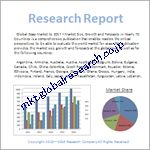目次
第1章.自律型建設機械の世界市場 エグゼクティブサマリー
1.1.自律型建設機械の世界市場規模・予測(2022年~2032年)
1.2.地域別概要
1.3.セグメント別概要
1.3.1.オートノミー別
1.3.2.タイプ別
1.3.3.用途別
1.4.主要トレンド
1.5.不況の影響
1.6.アナリストの提言と結論
第2章 自律型建設機械の世界市場世界の自律型建設機械市場の定義と調査前提
2.1.調査目的
2.2.市場の定義
2.3.調査の前提
2.4.推定方法
2.5.調査対象年
2.6.通貨換算レート
第3章.自律型建設機械の世界市場ダイナミクス
3.1.市場促進要因
3.1.1.インフラ開発プロジェクトの成長
3.1.2.AIとセンサーの技術進歩
3.1.3.熟練労働者不足への対応
3.2.市場の課題
3.2.1.初期投資コストの高さ
3.2.2.統合の複雑さとトレーニングの必要性
3.3.市場機会
3.3.1.新興市場での拡大
3.3.2.持続可能性とグリーン建設への取り組み
第4章.世界の自律型建設機械市場の産業分析
4.1.ポーターのファイブフォース分析
4.1.1.サプライヤーの交渉力
4.1.2.バイヤーの交渉力
4.1.3.新規参入者の脅威
4.1.4.代替品の脅威
4.1.5.競合他社との競争
4.2.PESTEL分析
4.2.1.政治的
4.2.2.経済
4.2.3.社会
4.2.4.技術
4.2.5.環境
4.2.6.法律
4.3.主な投資機会
4.4.業界を破壊するトレンド
第5章 自律型建設機械の世界市場自律型建設機械の世界市場規模・予測(自律性別) 2022年~2032年
5.1.セグメントダッシュボード
5.2.自律型建設機械の世界市場:オートノミー別、収益動向分析、2022年・2032年 (百万米ドル/億ドル)
5.2.1.半自律型
5.2.2.完全自律型
5.3.自律走行技術における新たなイノベーション
5.4.地域ごとの採用傾向
第6章 自律型建設機械の世界市場自律型建設機械の世界市場規模・タイプ別予測 2022-2032
6.1.セグメントダッシュボード
6.2.自律型建設機械の世界市場:タイプ別収益動向分析、2022年・2032年(百万米ドル/億ドル)
6.2.1.土木建設機械
6.2.1.1.掘削機
6.2.1.2.ブルドーザー
6.2.1.3.ローダー
6.2.2.建設車両
6.2.2.1.ダンプトラック
6.2.2.2.運搬車
6.2.3.荷役機器
6.2.3.1.フォークリフト
6.2.3.2.クレーン
6.2.4.コンクリートおよび道路建設機械
6.2.4.1.舗装
6.2.4.2.グレーダー
6.2.4.3.コンパクター
6.3.先進機械の将来展望
第7章.自律型建設機械の世界市場規模・用途別予測 2022-2032
7.1.セグメントダッシュボード
7.2.自律型建設機械の世界市場:用途別収益動向分析、2022年・2032年(百万米ドル/億ドル)
7.2.1.道路建設
7.2.1.1.舗装
7.2.1.2.グレーディング
7.2.1.3.締固め
7.2.2.建築工事
7.2.2.1.構造工事
7.2.2.2.敷地整備
7.2.3.その他(トンネル、橋梁など)
7.3.用途別の成長機会
第8章 自律型建設機械の世界市場自律型建設機械の世界市場規模・地域別予測 2022-2032
8.1.北米
8.1.1.米国
8.1.1.1.オートノミーの市場規模推移と予測、2022~2032年
8.1.1.2.タイプ別市場規模&予測、2022-2032年
8.1.2.カナダ
8.1.3.メキシコ
8.2.ヨーロッパ
8.2.1.イギリス
8.2.2.ドイツ
8.2.3.フランス
8.2.4.スペイン
8.2.5.イタリア
8.2.6.その他のヨーロッパ
8.3.アジア太平洋
8.3.1.中国
8.3.2.インド
8.3.3.日本
8.3.4.韓国
8.3.5.オーストラリア
8.3.6.その他のアジア太平洋地域
8.4.ラテンアメリカ
8.4.1.ブラジル
8.4.2.メキシコ
8.4.3.その他のラテンアメリカ
8.5.中東・アフリカ
8.5.1.アラブ首長国連邦
8.5.2.サウジアラビア王国(KSA)
8.5.3.南アフリカ
8.5.4.その他のMEA
第9章 競争力コンペティティブ・インテリジェンス
9.1.主要企業のSWOT分析
9.1.1.キャタピラー
9.1.2.ABボルボ
9.1.3.コマツ
9.2.トップ市場戦略
9.3.企業プロフィール
第10章.調査プロセス
10.1.調査プロセス
10.1.1.データマイニング
10.1.2.分析
10.1.3.市場推定
10.1.4.バリデーション
10.1.5.出版
表一覧
1.自律型建設機械の世界市場、レポートスコープ
2.自律走行型建設機械の市場規模予測:2022-2032年(百万米ドル/億米ドル)
3.タイプ別市場推定・予測、2022-2032年 (百万ドル/億ドル)
4.アプリケーション別市場推定・予測、2022-2032年 (百万米ドル/億米ドル)
5.地域別市場推定・予測、2022-2032年 (百万米ドル/億ドル)
6.米国のセグメント別市場予測、2022-2032年 (百万米ドル/億米ドル)
7.ドイツ市場タイプ別予測、2022-2032年(百万ドル/億ドル)
8.中国市場の用途別予測、2022-2032年 (百万ドル/億ドル)
9.各社の市場シェア分析、2023年(%)
10.主要企業のSWOT分析
「最終報告書には100以上の表が含まれます。最終成果物ではリストが更新される可能性があります。”
図表一覧
1.自律型建設機械の世界市場に関する調査手法
2.世界市場規模・予測動向、2022年~2032年
3.地域別売上構成比、2023年
4.競合状況の概要、2023年
5.市場促進要因と課題分析、2023年
6.地域別PESTEL分析
7.ポーターのファイブフォース分析
8.オートノミーの世界売上高動向(2023年
9. 市場における主要技術革新
10.自律走行装置の地域別導入パターン
「最終報告書には50以上の図表が含まれます。リストは最終成果物で更新される可能性があります。”
A key driver of this market is the surge in infrastructure development projects globally. From ambitious highway constructions to intricate urban transit systems, the demand for cutting-edge construction technologies has never been higher. Autonomous machinery, with its ability to streamline operations, reduce project timelines, and minimize human errors, addresses this demand adeptly. Coupled with advancements in imaging, LiDAR systems, and real-time data analytics, the reliability and accuracy of these machines continue to fuel their adoption.
Safety has become a cornerstone in the adoption of autonomous construction equipment. By mitigating the risks inherent to hazardous construction environments, these systems enhance site safety while adhering to stringent regulatory requirements. Additionally, the ongoing labor shortage in the construction industry underscores the necessity of automation, with autonomous systems bridging productivity gaps and reducing dependency on manual labor.
Cost efficiency also plays a pivotal role in driving this market. Although the initial investment in autonomous equipment is high, long-term benefits, including operational cost reduction and minimal material wastage, make it an attractive proposition for construction firms. As the global construction sector prioritizes sustainable practices, autonomous systems, which optimize energy consumption and resources, are becoming increasingly integral.
North America currently leads the market, propelled by technological innovations and significant investments in infrastructure. However, the Asia Pacific region is expected to exhibit the highest growth during the forecast period, supported by rapid urbanization and large-scale infrastructure projects in economies like China, India, and Japan. Europe’s focus on sustainable and emission-compliant solutions further reinforces the adoption of autonomous technologies in the region.
________________________________________
Major market players included in this report are:
1. Caterpillar
2. Bobcat Company
3. CNH Industrial America LLC
4. Built Robotics
5. AB Volvo
6. Komatsu Ltd.
7. Hitachi Construction Machinery Co., Ltd.
8. Royal Truck & Equipment
9. Sany Group
10. TOPCON CORPORATION
11. Develon
12. Liebherr Group
13. Doosan Infracore
14. Hyundai Construction Equipment
15. XCMG Group
________________________________________
The detailed segments and sub-segment of the market are explained below:
By Autonomy:
• Semi-Autonomous
• Fully Autonomous
By Type:
• Earth Moving Equipment
• Construction Vehicles
• Material Handling Equipment
• Concrete and Road Construction Equipment
By Application:
• Road Construction
• Building Construction
• Others
By Region:
North America
• U.S.
• Canada
• Mexico
Europe
• UK
• Germany
• France
Asia Pacific
• China
• India
• Japan
• South Korea
• Australia
Latin America
• Brazil
Middle East & Africa (MEA)
• UAE
• Kingdom of Saudi Arabia (KSA)
• South Africa
________________________________________
Years considered for the study are as follows:
Historical year – 2022
Base year – 2023
Forecast period – 2024 to 2032
Key Takeaways:
• Market Estimates & Forecast for 10 years from 2022 to 2032.
• Annualized revenues and regional level analysis for each market segment.
• Detailed analysis of geographical landscape with country-level analysis of major regions.
• Competitive landscape with information on major players in the market.
• Analysis of key business strategies and recommendations on future market approaches.
• Analysis of competitive structure of the market.
• Demand-side and supply-side analysis of the market.
❖ 免責事項 ❖
http://www.globalresearch.jp/disclaimer

